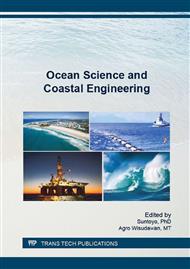[1]
S.A. Harvald, Resistance and propulsion of ships, Wiley, (1983).
Google Scholar
[2]
H. Schneekluth, V. Bertram, Ship design for efficiency and economy, Second edition, Butterworth-Heinemann, (1998).
Google Scholar
[3]
H. Cozijn, R. Hallmann, A. Koop, Analysis of the velocities in the wake of an azimuthing thruster using PIV measurements and CFD calculations, Maritime Research Institute Netherlands, (2010).
Google Scholar
[4]
H. Guldhammer, Formdata: some systematically varied ship forms and their hydrostatic data, Danish Technical Press, Copenhagen, (1962).
DOI: 10.3233/isp-1962-99103
Google Scholar
[5]
H.K. Versteeg, W. Malalasekera, An introduction to computational fluid dynamics: The finite volume method, Longman Scientific, Harlow, UK, (2007).
Google Scholar
[6]
R.R. Mitchel, M.B. Webb, J.N. Roetzel, F.K. Lu, J.C. Dutton, A Study of the base pressure distribution of a slender body of square cross section, In: Proc. 46th AIAA Aerospace Sciences Meeting and Exhibit, Reno, Nevada, (2008) 1-8.
DOI: 10.2514/6.2008-428
Google Scholar
[7]
J.B. Wang, Numerical simulation of viscous wake field and resistance prediction around slow-full ships considering free surface. In: Symposium on Ship Hydrodynamics, Shanghai, China, (2010).
Google Scholar
[8]
Z. -Z. Wang, Y. Xiong, R. Wang, X. -R. Shen, C. -H. Zhong, Numerical study on scale effect of nominal wake of single screw ship, Ocean Engineering, 104, (2015) 437-451.
DOI: 10.1016/j.oceaneng.2015.05.029
Google Scholar
[9]
P. Dymarski, M. Kraskowski, CFD optimization of vortex generators forming the wake flow of large ships, In: Proc. 13th Numerical Towing Tank Symposium, Duisburg, Germany (2010).
Google Scholar
[10]
F.R. Menter, Two-equation eddy-viscosity turbulence models for engineering applications. AIAA Journal, 32(8) (1994) 1598 - 605.
DOI: 10.2514/3.12149
Google Scholar
[11]
J. Banks, A.B. Phillips, S.R. Turnock, Free-surface CFD prediction of components of ship resistance for KCS, In: Proc. 13th Numerical Towing Tank Symposium, Duisburg, Germany (2010).
Google Scholar
[12]
J.D. Anderson, Computational fluid dynamics: The basics with applications, McGraw-Hill, Inc., New York, (1995).
Google Scholar
[13]
B. Melville-Jones, The measurement of profile drag by the pitot-traverse method, The Cambridge University Aeronautics Laboratory (R & M No. 1688), Technical Report of the Aeronautical Research Committee for the Year 1935-1936, Vol. I (1937).
Google Scholar


